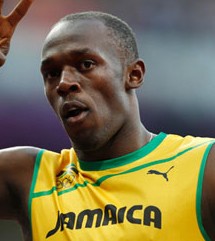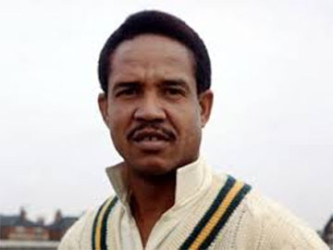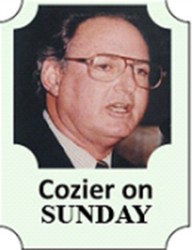In 1967, the celebrated English author Sir Neville Cardus wrote that no cricketer had “proven versatility of skill as convincingly as Sobers has done, effortlessly and after the manner born.”
Through a career lasting 30 years in the second half of the 20th century, Garry Sobers, the multi-talented left-hander from Barbados, epitomized West Indies cricket while enhancing its already established global reputation for excellence.
Almost half a century on, the towering Usain Bolt, the supreme sprinter, has become the Sobers of athletics. As Sobers did with cricket, he has inspired the upsurge of his sport as the supreme examplar of the quality among the tiny Anglo-Caribbean territories, principally, but not exclusively, his own Jamaica.
Echoing Cardus words on Sobers, Michael Johnson, the great American 400 metres champion, said of Bolt after his three gold medals at the on-going IAAF World Championships in Beijing: “There’s no-one quite like him, not on the track and certainly not off the track.”
“There are some people in this world who are super human,” Kelly Holmes, the outstanding British Olympic gold medalist, commented simply. She might have been referring to Sobers.


Bolt’s arrival and the surge of the exceptional runners, jumpers and throwers alongside him have been timely. They come precisely when cricket’s once incomparable strength has rapidly withered, for a variety of mostly self-inflicted reasons.
Throughout the West Indies prolonged periods of dominance, cricket was the passion of its fanatical public. Their initial triumph in a series in England in 1950 was a decisive breakthrough that brought forward a group of exciting players. In the 1960s, its exuberant style revitalized the sport in England and Australia, the game’s originators; for 15 years, from 1980 to 1995, they did not lose a Test series.
The outstanding players were products of the entire region, from Jamaica in the north to Guyana on the South American mainland.
Such fervor has wilted as, in 20 years, the West Indies have tumbled from the top to rank ninth among 10 Test and ODI teams; for the first time, they have failing to qualify for the eight-team Champions League in 2017 in England.
The performances of Bolt and other West Indians prominent at international athletics championships have lifted the consequent despair of West Indians for whom all else was once secondary to the exploits of their cricketers.
Quite apart from his speed, generated by long strides that cover the track with the power and speed of lightning, Bolt’s obvious Caribbean sense of fun even in the most vital races, make him the ideal energizer.
Barring a false start disqualification in the 2011 world championships, he is unbeaten for seven years in either of his favoured events, the 100 and 200 metres. His gold medal tally in Olympics and World Championships is 17, among them five for Jamaica in the sprint relays. He holds the world records in both 100 and 200 metres.
Given the circumstances, his dismissals of the latest, most threatening of his challengers, the twice-banned American Justin Gatlin, in their two confrontations in the IAAF World Championships in Beijing last week were unforgettable moments. The cheers echoed loud through the Caribbean, not least from sad cricket devotees in need of a boost.
In a West Indian context, there are unique, distinct differences between athletes, both male and female, who compete as individuals under the banners of their separate, independent nations and sing their own anthems, and the exclusively male cricketers who combine as one team under one flag with one anthem.
It predictably means that track and field has not yet created a select West Indian identity of its own, as cricket has done over the 115 years since the first combined West Indies team toured England.
Jamaicans still celebrate mainly Jamaican successes, which have been profuse, Trinidad mostly their own and so on. Still, they are all West Indians and regarded as such by their neighbours.
In cricket’s present predicament, those who now defy the size of their Caribbean homelands to literally bestride the world on the track provide welcome incentive for a bit of bragging.There are plain, contrasting reasons for the rapid reversal of roles of the two disciplines.
Jamaica’s athletic eminence is derived principally from a strong schools programme that culminates in annual championships, known simply as “Champs”.
Preparation is intense, competition razor-keen; attendance of some 20,000 at the National Stadium includes American talent scouts offering specialized scholarships at universities and colleges. Yet local coaching is of such a high standard and clubs so well organized that increasing numbers, among them Bolt, remain at home.
It is a template increasingly followed elsewhere although the U.S. remains a strong option for those seeking wider experience, much as West Indians once did in English county cricket.
The standard of play and organization in schools cricket that was once similarly strong and well organized in all the territories have generally declined. With a few notable exceptions, the most qualified coaches are attached to the first-class and Test teams rather than with the up-and-comers.
The upshot is a fall in standards at the age-group championships still staged by the West Indies Cricket Board (WICB); this year, a lack of finance led to the reduction of the under-19 matches from three days to one.
The basic system has changed little in Jamaica since Arthur Wint and Herb McKenley strode to gold and silver in the 400 metres at the London Olympics in 1948, Jamaica’s first medals.
In the intervening 67 years, West Indians, Jamaican and others, have repeatedly stood on the podium at major games.
Jamaica’s medal count at the Olympics is 17 golds, 30 silver, 20 bronze, an amazing tally for an island of less than four million inhabitants. Trinidad and Tobago’s (population 1.8 million) is 2-5-11. Jamaica have six golds going into today’s final day of the World Championships in Beijing, one more than the mighty U.S., two more that Britain.
Much as they did before they were belatedly introduced into the mainstream of West Indies cricket in 1966, proceeding to produce Andy Roberts, Viv Richards, Richie Richardson and Curtly Ambrose, all among the game’s finest players, the Leeward and Windward Islands are now making their mark.
The young star, Kirani James, won the 400 metres in the world championship in 2011 and the 2012 Olympics in London, Grenada’s first such successes. Earlier, Alleyne Francique was twice world indoor champion at the same distance.
Kim Collins of tiny St. Kitts and Nevis (population 48,000) was 100 metres champion at the 2008 world championships in France; he’s still challenging the best at the highest level; aged 39 he is the sport’s Shivnarine Chanderpaul.
In the Beijing championships on Friday, Sarah Proctor from Anguilla (35 square miles, population 15,000) leapt to silver in the long jump, representing Britain. Her fellow Anguillan-Brit, 20-year-old Zharnel Hughes, is widely predicted to follow her successes in the 200 metres.
Lauren Spencer and Jannelle Scheper, two St. Lucians, were in the women’s high jump final in Beijing.
In fact, the names of West Indian champions and contenders are to be found across every event at major track and field competition. Such prevalence was once the preserve of West Indies cricket before its recent, swift decline, initially triggered by the retirement of captain Viv Richards, the most intimidating batsman of his generation, and other key players.
As the effort continues to return it to its former glory and regenerate the trust of its public, athletes have stepped in to fill the breach.










